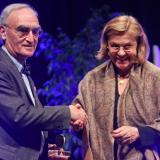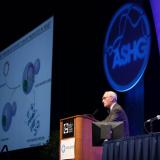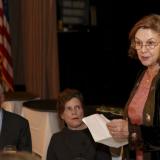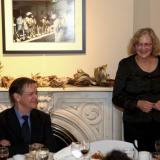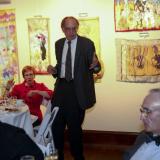2010 Gruber Genetics Prize
The pioneering work in yeast genetics of Gerald R. Fink has played a significant role in advancing the broader field of molecular genetics. Leading the list of Fink’s groundbreaking contributions was his development of yeast transformation, a now commonly used technique that allows scientists to introduce genetic material (DNA) from another organism into living yeast cells so that the expression and hereditability of the introduced DNA can be studied. Today, not only is yeast used to study the genetic dissection of basic cellular processes in other organisms, including humans, but it is used as a kind of mini-factory to produce medically important products, including insulin and vaccines. Among Fink’s many other discoveries was the identification of the genetic mechanisms by which disease-causing fungi form probing filaments and switch from being benign to infectious. Uncovering the genetic mechanisms behind the formation of the filaments has led to a better understanding of how fungi can overpower the immune system—clues that may lead to new life-saving drugs.
2010 Genetics Prize Recipient
Laureate Profile
Very few scientists were interested in the genetics of the common fungus known as “baker’s yeast” (Saccharamyces cerevisiae) when Gerald R. Fink began studying it in the 1960s. That changed dramatically after 1977, however, when Fink developed the landmark technique of yeast transformation—a method for introducing genetic material (DNA) from any organism (including humans) into living yeast cells so that the DNA can be studied for how it expresses itself and for how it passes on information to new generations. Until then, “nobody imagined [recombinant DNA technology] could be done in yeast,” he recalls. “It had only been done in bacteria.”
Today, yeast is used as a kind of biological factory to produce many medically important products, including insulin and vaccines. Fink’s yeast transformation method also laid the groundwork for conducting similar genetic manipulations in more complex organisms.
Fink went on to make other groundbreaking contributions to the field of yeast genetics, including the identification of the genetic mechanisms by which disease-causing fungi form probing filaments and switch from being benign to infectious. That finding has led to a better understanding of how a fungus like Candida albicans (the cause of vaginal infections in women, thrush in babies, and life-threatening infections in immunocompromised patients) can overpower the immune system—clues that are helping scientists develop life-saving anti-fungal drugs.
In addition to being known as the founder of modern yeast genetics, Fink is also renowned for teaching—and inspiring—a generation of geneticists. He was one of the first instructors of the Yeast Genetics Course at Cold Spring Harbor (called “a career-altering course” by many participants) and founding member and then director for 11 years (1990-2001) of the Whitehead Institute for Biomedical Research in Cambridge, Mass. Now 70, Fink continues to teach and conduct research at the Massachusetts Institute of Technology, where he has been a professor of genetics since 1982. “Genetics is not a technology, but a way of thinking about biological problems in a structured way,” he says. “It has its own language. I enjoy imparting that way of thinking, that language, to students—and seeing them slowly begin to look at the world around them in an entirely new way.”
Citation
The Peter and Patricia Gruber Foundation proudly presents the 2010 Genetics Prize to Gerald R. Fink, Ph.D., a founder of modern yeast genetics and a leader in the use of model-organism genetics to study diverse biological problems.
Fink developed a system that allows insertions of laboratory-modified-DNA molecules into their natural locations in the yeast chromosomes. His breakthrough technique enabled the genetic dissection of basic cellular processes and the manufacture of drugs and vaccines in yeast, as well as inspiring similar approaches to the genetic manipulation of diverse organisms.
Fink applied the "awesome power" of the new yeast genetics to discover how genomic information is transcribed, recombined, suppressed, transposed, and translated. In his own laboratory, he trained a legion of leading geneticists to apply yeast genetics to advance biomedical science, and inspired many more to do so through his teaching and writing.








